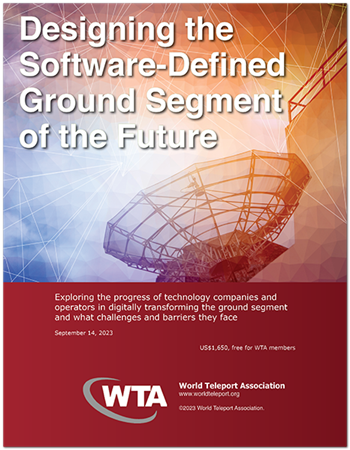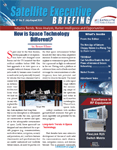Hardware to Software:The Ground Segment Evolution
by Robert Bell
New York City, February 1, 2024--Innovations taking place in the satellite sector continue to reshape the satellite services market. First it was HTS massively expanding the supply of bandwidth and reducing the cost per bit. Then it was LEO broadband, which made dynamic software-based management critical to connectivity.
Looking forward, the next generation of satellites will be defined by software, designed to serve a market in which IP content is the dominant traffic. Software-defined satellites are fully reconfigurable in orbit, allowing bandwidth to be dynamically adapted and flexibly reconfigured, so coverage, frequency and bandwidth allocation can be changed to meet demand. This enables even greater flexibility, scalability and cost-effectiveness in satellite communications.
From Sky to Ground
This digital transformation in the sky is creating immense pressure for a similar transformation on the ground, which was the subject of a recent WTA report, Designing the Software-Defined Ground Segment of the Future. Based on interviews with teleport and technology executives, it aims to separate the reality from the hype and uncover both the promise of digital ground segment and the challenges in delivering it.
WTA report, Designing the Software-Defined Ground Segment of the Future. Based on interviews with teleport and technology executives, it aims to separate the reality from the hype and uncover both the promise of digital ground segment and the challenges in delivering it.
Today, most ground systems remain largely hardware-centric facilities. These legacy architectures are often proprietary and designed for bent-pipe, fixed satellite delivery models with relatively static payloads. This infrastructure developed because it was the most efficient, cost-effective means to serve the older generation of satellites in orbit. As the satellite layer becomes more complex, more dynamic and more flexible, the ground segment needs to transition to a software-based infrastructure to match those capabilities.
The transition to digital operations is underway, but how fast or slow organizations proceed – or how far they go down the path – can depend on business models, customer mix and applications, as well as the current infrastructure and partners. “The ground system will remain analog for the foreseeable future. It’s not going to be a complete change by 2023,” a technology provider executive said. “The reality is it will be gradual over many years. But some applications are making the digital transition faster.”
The digital transition is being factored into the value of the ground segment economy, Euroconsult said in a 2022 forecast. The market will reach a value of US$ 3.6 billion by the end of the 10-year window, driven by the growing demand for data and services. The transformation towards very high throughput connectivity and non-geostationary constellations is already counting for most of the growth, and “the deployment of software-definition in both satellite systems and within ground infrastructure will also stand as a key item in the product roadmap. Satellite operators are relying more and more on virtualization in place of physical hardware, reducing expenditures and improving ground segment flexibility.”
To take full advantage of the innovations in orbit, the ground segment needs to more fully integrate with the satellite layer to become one
| "...The drivers of multilayer connectivity include the ongoing decline in satellite bandwidth costs, technical advances that make it much easier to seamlessly switch between different pathways, and customer demand..." |
synchronized system. To achieve this, teleport operators need to incorporate open, flexible, automated software.
“We are seeing every day with the growth of AI that operations need to change; to be more managed and faster. AI is the new way to say automation – an evolution of automation. It’s moving from manual operations to operations being done by machines,” a technology provider executive said. “In that regard, it’s a similar scenario in the satellite domain. What has been analog for years is now becoming digitized. What has been digitized can be better. We see how both technology and teleports are being digitized with more software and see how operations are being much more managed with AI, with machine learning or just automation from the previous generation.”
To enable this, teleports must convert analog RF signals to digital packets and virtualize operations via software. This will make the ground station more agile and efficient, enabling easier management of optimization of network traffic as well as deliver more cost-efficient operations. It will also create opportunities to provide new services and enter new markets that are rising up due to the changing communications needs.
“There is a lot of talk about what is happening in space – multiorbital constellations, the flexible satellite, more capacity. If you have a completely static ground segment, all of that is of no use,” a technology provider executive said. “If want to create a new beam but have to bring new hardware into the teleport to do it, that’s not really flexible. Teleports need to digitize so they can reconfigure the ground segment with just a few clicks. We need ‘new ground’ to enable the new capabilities in space,” the official said.
“A few years ago, there were conversations about digitalization and virtualization, and everyone was wondering what was going on,” another technology provider official said. “This year, everyone seems to be onboard. They can see this as the future, but now the questions are ‘When is the future? How will I make transition? When will I make it? What does it mean? How does it work?’ Over the last year, the satellite sector has turned the corner on recognizing that this is the future. Now people are wondering about the details,” the executive said.
--------------------------------------
.jpg) Robert Bell is Executive Director of the World Teleport Association, which represents the world’s most innovative teleport operators, carriers and technology providers in 46 nations. Robert Bell has over 30 years of experience as an association manager and business consultant for both nonprofit and profit-driven and organizations operating in the IT outsourcing, telecommunications, and financial services industries. He has led business development missions and conducted workshops and Master Classes in the Americas, Europe and Asia. He can be reached at: rbell@worldteleport.org
Robert Bell is Executive Director of the World Teleport Association, which represents the world’s most innovative teleport operators, carriers and technology providers in 46 nations. Robert Bell has over 30 years of experience as an association manager and business consultant for both nonprofit and profit-driven and organizations operating in the IT outsourcing, telecommunications, and financial services industries. He has led business development missions and conducted workshops and Master Classes in the Americas, Europe and Asia. He can be reached at: rbell@worldteleport.org
Designing the Software-Defined Ground Segment of the Future is available for free to members and for sale to non-members at https://www.worldteleport.org/store/viewproduct.aspx?id=22701240





